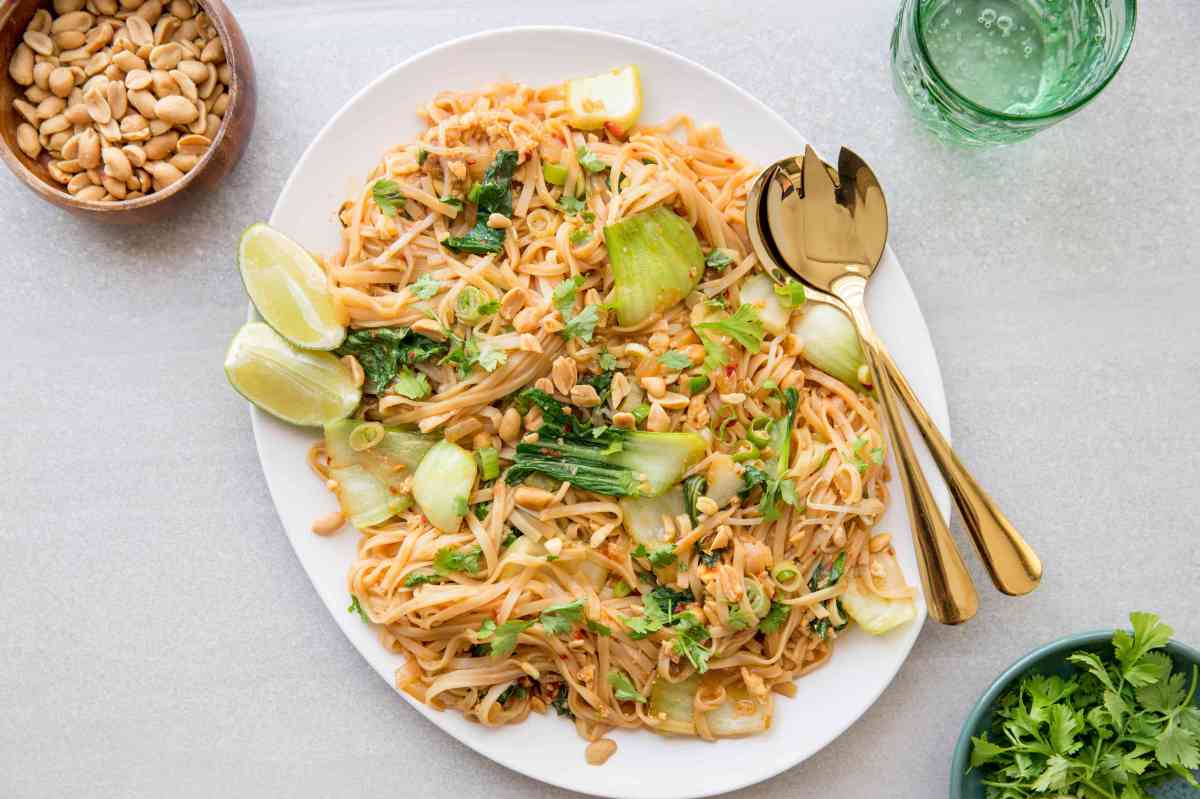Embark on a culinary journey through the vibrant world of Thai vegan cuisine! Imagine the rich aroma of fragrant coconut milk simmering with fiery chilies, the vibrant hues of green curry glistening with fresh herbs, and the satisfying textures of perfectly cooked noodles coated in a tangy, sweet, and spicy sauce. This exploration of spicy Thai vegan dinner recipes unveils a collection of exciting dishes, each bursting with flavor and designed to tantalize your taste buds. From classic Pad Thai variations to innovative green curries and delightful appetizers, we’ll guide you through creating authentic Thai vegan meals that are both delicious and surprisingly easy to make.
We’ll delve into detailed step-by-step instructions, offering helpful tips and ingredient substitutions to accommodate various dietary needs and preferences. Discover the secrets to achieving the perfect balance of spice and flavor, explore the versatility of different vegan milks, and learn how to elevate your dishes with stunning plating techniques. Get ready to transform your dinner table into a vibrant Thai street food market, all from the comfort of your own kitchen.
Spicy Thai Vegan Appetizers & Sides

These vibrant and flavorful appetizers and sides are designed to complement a variety of spicy Thai vegan main courses, offering a delightful contrast in textures and tastes. They’re perfect for sharing and adding a touch of elegance to your Thai feast. Each recipe focuses on fresh, readily available ingredients and simple preparation methods, making them accessible to home cooks of all skill levels.
Three Spicy Thai Vegan Appetizers and Sides
The following recipes offer a diverse range of flavors and textures, showcasing the versatility of Thai cuisine in a vegan context. Each dish provides a unique culinary experience, enhancing the overall dining experience.
- Spicy Mango Salsa with Crispy Tofu Crumbles: This vibrant salsa combines the sweetness of ripe mango with the fiery kick of Thai chili peppers, balanced by the refreshing acidity of lime juice and the satisfying crunch of crispy tofu.
- Ingredients: 1 ripe mango, diced; 1/2 red bell pepper, finely diced; 1/4 cup red onion, finely diced; 2-3 Thai chilies, finely minced (adjust to taste); 2 tablespoons fresh cilantro, chopped; 2 tablespoons lime juice; 1/4 cup firm or extra-firm tofu, pressed and crumbled; 1 tablespoon olive oil; salt and pepper to taste.
- Preparation: Heat olive oil in a pan over medium heat. Add tofu crumbles and cook until golden brown and crispy. In a bowl, combine mango, bell pepper, red onion, chilies, cilantro, and lime juice. Gently fold in the crispy tofu. Season with salt and pepper. Serve with tortilla chips or as a topping for your main course.
- Crispy Coconut Shrimp with Spicy Peanut Sauce: These delightful “shrimp” are made from cauliflower florets, coated in a flavorful coconut mixture, and deep-fried to golden perfection. The spicy peanut sauce adds a rich, nutty depth.
- Ingredients: 1 head cauliflower, cut into bite-sized florets; 1/2 cup unsweetened shredded coconut; 1/4 cup cornstarch; 1/4 cup all-purpose flour; 1 teaspoon garlic powder; 1/2 teaspoon ginger powder; 1/4 teaspoon salt; 1/4 teaspoon black pepper; oil for deep frying; Spicy Peanut Sauce: 1/4 cup peanut butter; 2 tablespoons soy sauce; 2 tablespoons rice vinegar; 1 tablespoon lime juice; 1 tablespoon maple syrup; 1-2 Thai chilies, minced; 1 tablespoon water.
- Preparation: Combine coconut, cornstarch, flour, garlic powder, ginger powder, salt, and pepper in a bowl. Toss cauliflower florets in the mixture until evenly coated. Deep fry in hot oil until golden brown and crispy. For the sauce, whisk together peanut butter, soy sauce, rice vinegar, lime juice, maple syrup, chilies, and water until smooth. Serve the crispy cauliflower “shrimp” with the spicy peanut sauce.
- Spicy Cucumber Salad with Sesame Seeds: A refreshing and light salad that provides a cooling counterpoint to spicier dishes. Thinly sliced cucumbers are tossed in a vibrant dressing with a hint of chili and a sprinkle of sesame seeds for added texture.
- Ingredients: 2 cucumbers, thinly sliced; 1/4 cup rice vinegar; 2 tablespoons soy sauce; 1 tablespoon sesame oil; 1 tablespoon sugar; 1-2 Thai chilies, minced; 1 tablespoon sesame seeds.
- Preparation: In a bowl, whisk together rice vinegar, soy sauce, sesame oil, sugar, and chilies. Add the sliced cucumbers and toss gently to coat. Sprinkle with sesame seeds and serve immediately.
The Mango Salsa offers a sweet and spicy contrast, with a satisfyingly crunchy texture from the tofu. The Coconut Shrimp provides a rich, savory experience, with the crispy exterior giving way to a tender interior, complemented by the creamy peanut sauce. Finally, the Cucumber Salad delivers a refreshing coolness, its crisp texture and subtle spice cutting through the richness of other dishes. Together, these appetizers and sides create a balanced and exciting culinary journey.
Ingredient Substitutions and Adaptations
Mastering the art of Thai vegan cooking involves understanding the flexibility inherent in many recipes. While authentic ingredients contribute to the vibrant flavors, creative substitutions allow for dietary adjustments and cater to individual preferences. This section explores how to modify common ingredients, adjust spice levels, and adapt recipes for various cooking methods.
Ingredient Substitutions for Allergies and Dietary Restrictions
Many common Thai ingredients have suitable substitutes for those with allergies or specific dietary needs. For example, soy sauce, a staple in many Thai dishes, can be easily replaced with tamari (gluten-free soy sauce) for individuals with gluten sensitivities. Coconut aminos offer a slightly sweeter, less salty alternative. Those avoiding soy altogether might consider using a combination of rice vinegar, maple syrup, and seaweed flakes to create a similar umami profile. Similarly, peanuts, frequently used in sauces and garnishes, can be substituted with cashews, sunflower seeds, or even pumpkin seeds, offering a textural and flavor variation depending on the dish. For those with nut allergies, carefully consider alternative options and always double-check ingredient labels.
Adjusting Spice Levels
The fiery heat of Thai cuisine is a defining characteristic, but the level of spiciness can be easily tailored to individual preferences. The primary source of heat in most Thai vegan dishes is chili. Start by using less chili than the recipe suggests, and gradually add more to your taste. Fresh chilies offer a brighter, fresher heat compared to dried chilies, which tend to be more intense. For a milder heat, remove the seeds and membranes from the chilies before adding them to the dish. Conversely, for extra heat, add a few slices of bird’s eye chili or a dash of chili garlic sauce. Remember, the spiciness can also be balanced by the addition of other flavorful ingredients, such as lime juice, lemongrass, or galangal, which can temper the heat without diminishing the overall flavor profile.
Adapting Recipes for Different Cooking Methods
Thai vegan recipes are remarkably adaptable to various cooking methods. Many stir-fries, traditionally cooked over high heat in a wok, can be successfully adapted for a slow cooker, resulting in a more tender and deeply flavored dish. For instance, a red curry can be simmered gently in a slow cooker for several hours, allowing the flavors to meld beautifully. Similarly, the Instant Pot offers a quick and efficient way to cook many Thai dishes. The pressure cooking function can significantly reduce cooking times while maintaining the integrity of the ingredients. For example, a hearty Massaman curry, typically a long simmering dish, can be prepared in a fraction of the time using the Instant Pot’s pressure cooking and sauté functions. Remember to adjust cooking times and liquid amounts according to the specific appliance’s instructions and the recipe’s requirements.
Visual Descriptions of Dishes
Thai vegan cuisine offers a vibrant feast for the eyes, as much as for the palate. The careful arrangement of colors, textures, and ingredients elevates each dish beyond simple sustenance, transforming it into a work of art. The following descriptions aim to capture the visual allure of three distinct dishes, highlighting the techniques used to enhance their aesthetic appeal.
Visual Appeal of Three Spicy Thai Vegan Dishes
Three distinct dishes showcase the visual diversity of spicy Thai vegan cuisine. First, a vibrant Pad See Ew features glossy, dark soy sauce-slicked noodles interwoven with bright green broccoli florets and the vivid orange of carrots. The dish is scattered with crispy tofu, providing textural contrast against the soft noodles. The overall effect is one of rich, earthy tones punctuated by pops of bright color. Ideal plating involves a slightly mounded presentation, allowing the colors and textures to be easily appreciated.
Secondly, a Green Curry showcases a lush, vibrant green sauce, its creamy texture subtly suggested by the gentle pooling around the tender pieces of eggplant and bamboo shoots. Red bell peppers add splashes of bright crimson, contrasting beautifully with the deep green. A scattering of fresh basil leaves adds a touch of freshness and a pop of green. The plating should highlight the vibrant green of the curry, perhaps served in a shallow bowl to allow the viewer to appreciate the depth of color and the variety of textures within.
Finally, a Tom Yum soup, while not as visually dense as the previous dishes, offers a different kind of appeal. The clear broth, subtly tinged with the golden hue of lemongrass and galangal, is punctuated by the bright red of chili flakes, the vibrant green of kaffir lime leaves, and the white of mushrooms and tofu. The contrasting colors and textures create a visually appealing and appetizing presentation. Plating in a clear bowl allows the viewer to fully appreciate the clarity of the broth and the individual ingredients within.
Red Curry Visual and Aromatic Description
The aroma of a red Thai vegan curry is intensely evocative, a heady blend of fragrant spices. The rich, deep scent of red chilies mingles with the earthy notes of galangal and lemongrass, tempered by the subtle sweetness of coconut milk. Hints of kaffir lime leaves add a citrusy freshness, while the background aroma of ginger and garlic adds depth and complexity. Visually, the curry is a captivating sight. The sauce itself is a deep, rich crimson, its texture thick and luscious, clinging to the various vegetables. Chunks of vibrant red bell peppers and bamboo shoots peek through the vibrant red sauce, along with perhaps some eggplant, tofu, or other vegetables depending on the recipe. The overall effect is one of intense color and rich texture, promising a flavor experience as rich and complex as its appearance. The glistening sheen of the coconut milk adds to the allure, suggesting a creamy, comforting texture that contrasts beautifully with the vibrant spices.
This culinary adventure into the world of spicy Thai vegan recipes has shown you that creating delicious and authentic Thai food without animal products is entirely achievable and incredibly rewarding. From the fiery kick of a red curry to the subtle sweetness of a Pad Thai, each dish offers a unique sensory experience, showcasing the vibrant flavors and textures of Thai cuisine. Remember, the key to success lies in carefully balancing the spices, using fresh, high-quality ingredients, and letting your creativity guide you. So, don your chef’s hat, gather your ingredients, and prepare to embark on your own culinary journey into the heart of Thailand – all from your own kitchen!
Top FAQs
Can I make these recipes ahead of time?
Many components can be prepped in advance. Curries often taste even better the next day! Store properly in airtight containers in the refrigerator.
Where can I find authentic Thai ingredients?
Asian grocery stores are your best bet for finding a wide variety of authentic Thai ingredients, including unique spices and pastes.
What if I don’t like spicy food?
Easily adjust the spice level by reducing or omitting chili peppers. Start with a small amount and add more to taste.
Are these recipes gluten-free?
Most can be adapted to be gluten-free by using gluten-free soy sauce or tamari and ensuring other ingredients are gluten-free.


